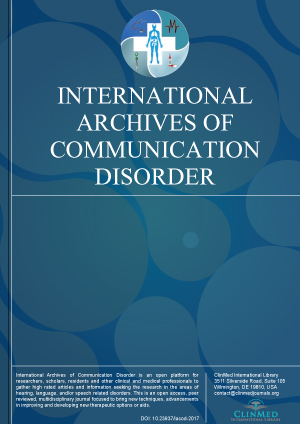Archive
Open Access DOI:10.23937/IACOD-2017/1710012
The Relation between Functional Play and Other Forms of Cooperation and Word Learning in ASD
Christina F Papaeliou, Kokonitsa Sakellaki and Asimenia Papoulidi
Article Type: Original Article | First Published: April 08, 2019
This study focuses on the relation between functional play and other aspects of cooperation with language, especially vocabulary production, in children with Autism Spectrum Disorder (ASD). Ten children with ASD (mean CA 54.1 months) were compared with 10 typically developing (TD) children matched for mental and language age (mean CA 17.1 months). Children's behaviors were assessed from video-recordings during spontaneous mother-child play. Results demonstrated that children with ASD take signif...
Article Formats
- Abstract
- Full Article
- XML
- EPub Reader
Open Access DOI:10.23937/IACOD-2017/1710011
Genes Involved in the Development of Autism
Ines Lopes Cardoso and Sandra Almeida
Article Type: Research Article | First Published: March 27, 2019
Autism is still considered a very complex disease, since it has diverse etiology, with multiple factors apparently associated with its appearance. However, none of them reveals to be totally responsible for its development. Nowadays, this disorder is considered to have a strong genetic component with the interaction of several genes. Furthermore, other diseases with well-known etiology might also be related with autism. The aim of this review is to discuss, through bibliographic search, genetic ...
Article Formats
- Abstract
- Full Article
- XML
- EPub Reader
Open Access DOI:10.23937/iacod-2017/1710010
Can Cochlear Implantation Improve Voice in Speaking Children?
Rabeea A El Sabeela and Safinaz N Azab, MD
Article Type: RESEARCH ARTICLE | First Published: March 07, 2019
After cochlear implantation fundamental frequency did not change significantly. However, an improvement was noticed in measurements of jitter (p = 0.006) and shimmer (p = 0.021) as early as 6 months after the implantation. The noise-to-harmonic ratio improved (p = 0.010) 12 months after implantation. The children implanted before or at the age of 4 years showed a significant improvement in jitter (p = 0.003) and shimmer (p = 0.004) as early as 6 months noise-to harmonic ratio (p = 0.021) 12 mont...
Article Formats
- Abstract
- Full Article
- XML
- EPub Reader

Volume 2
Issue 1
Issue 1
